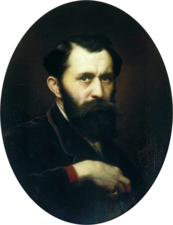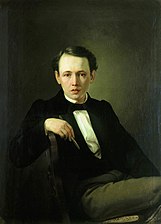art.wikisort.org - Artist
Vasily Grigorevich Perov (Russian: Васи́лий Григо́рьевич Перо́в; 2 January 1834 (21 December 1833 O.S.) – 10 June (29 May O.S.) 1882) was a Russian painter, a key figure of the Russian Realist movement and one of the founding members of Peredvizhniki.[1]
This article may be expanded with text translated from the corresponding article in Russian. (November 2015) Click [show] for important translation instructions.
|
Vasily Grigorievich Perov | |
|---|---|
 Portrait of Vasily Perov by Ivan Kramskoi (1881) | |
| Born | 2 January 1834 Tobolsk, Russian Empire |
| Died | 26 May 1882 (aged 48) Kuzminki, Moscow Governorate, Russian Empire |
| Nationality | Russian |
| Education | Member Academy of Arts (1866) Professor by rank (1870) |
| Alma mater | Moscow School of Painting, Sculpture and Architecture |
| Known for | Painting |
| Notable work | Easter Procession (1865) The Hunters at Rest (1871) Portrait of Fyodor Dostoyevsky (1872) |
| Movement | Realism, Peredvizhniki |
| Awards | Minor silver medal (1856) Grand silver medal (1857) Minor gold medal (1860) |
| Patron(s) | Pavel Tretyakov |
Life and career

Vasily Perov was born on 2 January 1834 (21 December 1833 Old Style) in Tobolsk, Tobolsk Governorate, Russian Empire, as Vasily Grigorevich Vasiliev (Васи́лий Григо́рьевич Васильев). Perov was an illegitimate son of the local procurator baron, Baron Gregor Gustav Friedrich von Krüdener, who belonged to a German and Baltic German noble family, which belonged to the Uradel, and Akulina Ivanova, a native citizen of Tobolsk. Although Perov's parents married soon after his birth, there was no legal way to inherit his father's name and baron title, so he was registered under his godfather's surname — Vasiliev. He later changed his surname to Perov — a nickname given to him by his teacher who taught him calligraphy as a child (the word pero means feather in Russian).[2]
After completing a course at Arzamas uyezd school, Perov was transferred to the Alexander Stupin art school also located in Arzamas. In 1853, Perov was admitted to the Moscow School of Painting, Sculpture and Architecture in Moscow, where he learned from several renowned artists.[3] In 1856, Perov was awarded with a minor silver medal, presented to the Imperial Academy of Arts, for his sketch of a boy's head. Later the Academy gave him many other awards: in 1857 a major silver medal for Commissary of Rural Police Investigating, a minor golden medal for the Scene on a Grave and the Son of a Dyak Promoted to First Rank, and in 1861 a major golden medal for Sermon in a Village.

In 1862, after receiving the right to a state-paid trip abroad together with a golden medal, Perov traveled to Western Europe, visiting several German cities, and then Paris. During this time he created paintings depicting scenes from European streetlife, such as the Vendor of statuettes, the Savoyard, the Organ-Grinder in Paris, the Musicians and the Bystanders, and the Paris Ragpickers. Returning to Moscow early, from 1865 to 1871 Perov created his best known pieces, The Queue at The Fountain, A Meal in the Monastery, Last Journey, Troika, the Lent Monday, Arrival of a New Governess in a Merchant House, the Drawing Teacher, A Scene at the Railroad, the Last Tavern at Town Gate, the Birdcatcher, the Fisherman, and the Hunters at Rest. In 1866, Perov received the title of an academician, and in 1871 the position of a Professor at Moscow School of Arts, Sculpture and Architecture. It was around this period that Perov joined the Peredvizhniki, a collective of Russian realist painters formed as an artists cooperative in protest of academic restrictions.

Perov died on 10 June (29 May O.S.), 1882 in the village Kuzminki, now Kuzminki District of Moscow) from tuberculosis, and his body was interred at the Donskoy Cemetery.
Selected works
- Self-portrait (1851)
 Self-portrait (1870)
Self-portrait (1870)- Paris Ragman (1864)
- Alexander Ostrovsky (1871)
- Fyodor Dostoyevsky (1872)
- Old man (1868)
- A Scene at the Railroad (1868)
- The Bird-Catcher (1870)
- Sleeping Children (1870)
- Easter Procession
- A Governess Arriving at a Merchant's House
- Pugachev's Judgement (1879)
- Nikita Pustosviat. Dispute on the Confession of Faith (1881)
- Drinking tea in Mytishchi, near Moscow.
References
- "vasily-perov". www.visual-arts-cork.com. Retrieved January 2, 2016.
- Perov, Vasily Grigorievich in the Russian Biographical Dictionary in 25 Volumes. Saint Petersburg, 1896—1918.
- "biography/Vasily-G-Perov". www.britannica.com. Retrieved January 2, 2016.
External links
- Perov at Olga's Gallery
- Artists Illustrating Boys Fashions: Vasily Perov (Russia, 1834-82)
- Vasily Perov at Tanais Gallery
На других языках
[de] Wassili Grigorjewitsch Perow
Wassili Grigorjewitsch Perow (russisch Василий Григорьевич Перов, wiss. Transliteration Vasilij Grigor'evič Perov; * 21. Dezember 1833jul. / 2. Januar 1834greg. in Tobolsk; † 29. Maijul. / 10. Juni 1882greg. in Moskau) war ein russischer Maler und eines der Gründungsmitglieder der Peredwischniki.- [en] Vasily Perov
[fr] Vassili Perov
Vassili Grigorievitch Perov (en russe : Василий Григорьевич Перов; ISO 9 : Vasilij Grigor'evič Perov) est un peintre russe né le 21 décembre 1833 (2 janvier 1834 dans le calendrier grégorien) à Tobolsk et mort le 29 mai 1882 (10 juin 1882 dans le calendrier grégorien) d'une tuberculose près de Moscou. Il fut membre du groupe dit des Ambulants.[it] Vasilij Grigor'evič Perov
Vasilij Grigor'evič Perov (Tobol'sk, 2 gennaio 1834 – Mosca, 10 giugno 1882) è stato un pittore russo ed uno dei fondatori del gruppo dei Peredvižniki, un gruppo di pittori realisti. Dopo il completamento della scuola ad Arzamas, fu trasferito alla scuola d'arte Aleksandr Stupin, anch'essa ad Arzamas. Nel 1853 fu ammesso alla scuola di pittura, scultura ed architettura di Mosca, dove imparò da diversi artisti rinomati.[ru] Перов, Василий Григорьевич
Васи́лий Григо́рьевич Перо́в (21 декабря 1833 (2 января 1834), Тобольск — 29 мая (10 июня) 1882) — русский живописец, один из членов-учредителей Товарищества передвижных художественных выставок.Другой контент может иметь иную лицензию. Перед использованием материалов сайта WikiSort.org внимательно изучите правила лицензирования конкретных элементов наполнения сайта.
WikiSort.org - проект по пересортировке и дополнению контента Википедии













